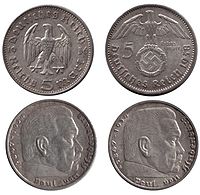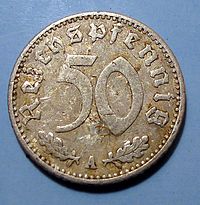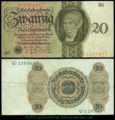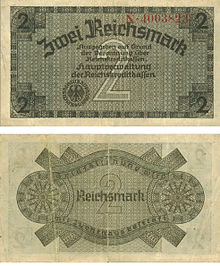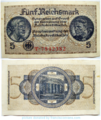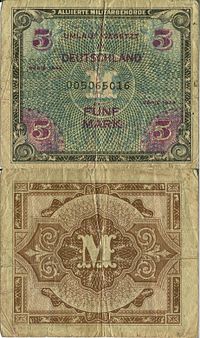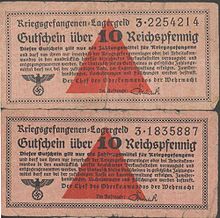- Reichsmark
-
Reichsmark (German) 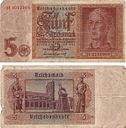
2 ℛℳ,- Coin with Paul von Hindenburg 5 ℛℳ,- Banknote with a German youth ISO 4217 code DRM[citation needed] User(s)  Weimar Republic
Weimar Republic
 Nazi Germany
Nazi Germany
 Flensburg Government
Flensburg Government
 Allied-occupied Germany
Allied-occupied GermanyPegged by Belgian franc, Bohemian and Moravian koruna, Bulgarian lev, Danish krone, French franc, Italian lira, Luxembourg franc, Dutch gulden, Norwegian krone, Polish złoty, Serbian dinar, Slovak koruna, Ukrainian karbovanets in World War II as similar rates Subunit 1/100 Reichspfennig Symbol ℛℳ Reichspfennig rpf Plural Reichsmark Reichspfennig Reichspfennig Coins 1 rpf, 2 rpf. 5 rpf, 10 rpf, 50 rpf, 1 ℛℳ, 2 ℛℳ, 5 ℛℳ Banknotes 5 ℛℳ, 10 ℛℳ, 20 ℛℳ, 50 ℛℳ, 100 ℛℳ, 1000 ℛℳ Central bank Reichsbank This infobox shows the latest status before this currency was rendered obsolete. The Reichsmark (literally in English: Reich's mark; sign: ℛℳ) was the currency in Germany from 1924 until June 20, 1948. The Reichsmark was subdivided into 100 Reichspfennig.
Contents
History
The Reichsmark was introduced in 1924 as a permanent replacement for the Papiermark. This was necessary due to the 1920s German inflation which had reached its peak in 1923. The exchange rate between the old Papiermark and the Reichsmark was 1 ℛℳ = 1012 Papiermark (one "trillion" in US English, one "billion" in British English, German and other European languages, see long and short scales). To stabilize the economy and to smooth the transition, the Papiermark was not directly replaced by the Reichsmark, but by the Rentenmark, an interim currency backed by the Deutsche Rentenbank, owning industrial and agricultural real estate assets. The Reichsmark was put on the gold standard at the rate previously used by the Goldmark, with the U.S. dollar worth 4.2 ℛℳ.
During the Second World War, Germany established fixed exchange rates between the Reichsmark and the currencies of the occupied and allied countries, often set so as to give the Germans economic benefits. The rates were as follows:
Currency Date set Value in ℛℳ Belgian franc May 1940 0.1 July 1940 0.08 Bohemian and Moravian koruna 1939 0.1 Bulgarian lev 1940 0.03 Danish krone 1940 1 French franc May 1940 0.05 Italian lira 1943 0.1 Luxembourg franc May 1940 0.25 July 1940 0.1 Dutch Guilder May 10, 1940 1.5 July 17, 1940 1.327 Norwegian krone 1940 0.6 ? 0.57 Polish złoty 1939 0.5 Pound sterling (Channel Islands) 1940 5 (initially) Independent State of Croatia kuna April 1941 0.05 Slovak koruna 1939 0.1 October 1, 1940 0.086 Ukrainian karbovanets 1942 0.1 After the Second World War, the Reichsmark continued to circulate in Germany, with new banknotes printed in the U.S. and U.S.S.R. as well as coins. The Reichsmark was replaced in June 1948 by the Deutsche Mark in West Germany and later in the same year by the East German Mark (colloquially also "Ostmark", since 1968 officially "Mark der DDR") in East Germany.
Coins
In 1924, coins were introduced in denominations of 1, 2, 5, 10 and 50 Reichspfennig, and 1 and 3 Mark (not Reichsmark). The 1 and 2 Reichspfennig were struck in bronze, with the 5, 10 and 50 Reichspfennig in aluminium-bronze and the two highest denominations in .500 fine silver. In 1925, .500 fine silver 1 and 2 Reichsmark coins were introduced for circulation, along with the first commemorative 3 and 5 Reichsmark coins. In 1927, nickel 50 Reichspfennig coins were introduced along with regular-type 5 Reichsmark coins, followed by the 3 Reichsmark coin in 1931.
4 Reichspfennig coins were issued in 1932 as part of a failed attempt by the Reichskanzler Heinrich Brüning to reduce prices through use of 4 Reichspfennig pieces instead of 5 Reichspfennig coins. Known as the Brüningtaler or Armer Heinrich ("poor Heinrich"), they were demonetized the following year. See Brüningtaler (German).
The quality of the Reichsmark coins decreased more and more towards the end of World War II and misprints happened more frequently. This led to an increase in counterfeiting of money.
Production of silver 1 Reichsmark coins ended in 1927. In 1933, nickel 1 Reichsmark coins were introduced, and new silver 2 and 5 Reichsmark coins were introduced which were smaller but struck in .625 and .900 fineness so as to maintain the amount of silver. Production of the 3 Reichsmark coin ceased altogether. In 1935, aluminium 50 Reichspfennig coins were introduced, initially for just the one year. The nickel coins continued to be produced up to 1939. From 1936 on, all coins except the 1 Reichsmark and the first version (1935–36) of the 5 Reichsmark coin (bearing the image of the late Reichspräsident Paul von Hindenburg) bore the Nazi insignia.
During World War II, bronze and aluminium-bronze coins were replaced by zinc and aluminium, with the 2 Reichspfennig and the 1, 2 and 5 Reichsmark coins no longer issued. Aluminium 50 Reichspfennig coins were reintroduced to replace the nickel versions. This time around they had a longer run, being produced from 1939 - 1944. Lower denominations were produced in zinc from 1940 onwards. The last production of coins bearing the swastika was in 1944 (1, 5, 10 and 50 Reichspfennig) and 1945 (1 and 10 Reichspfennig only).
After the war, the Allies issued coins in relatively small numbers between 1945 and 1948:
- 1945-46: 1 and 10 Reichspfennig
- 1947-48: 5 and 10 Reichspfennig
These coins were issued with designs very similar to those minted in 1944-45, with the exception that the swastika was removed from beneath the eagle on the reverse.
Banknotes
The first Reichsmark banknotes were introduced by the Reichsbank and state banks such as those of Bavaria, Saxony and Baden. The first Reichsbank issue of 1924 came in denominations of 10, 20, 50, 100 and 1000 Reichsmark. This was followed by a second issue in the same denominations, dated between 1929 and 1936. A 20 Reichsmark note was introduced in 1939, using a design taken from an unissued Austrian 100 schilling banknote type. 5 Reichsmark notes were issued in 1942. Throughout this period, the Rentenbank also issued banknotes denominated in Rentenmark, mostly in low denominations.
Following their occupation of Germany, the Allies issued banknotes dated 1944. These were printed in similar colours with different sizes for groups of denominations. Notes were issued for ½, 1, 5, 10, 20, 50, 100 and 1000 Mark (not Reichsmark). The issuer was the Alliierte Militärbehörde ("Allied military authorities") with In Umlauf gesetzt in Deutschland ("in legal circulation in Germany") printed on the obverse.
In 1947 Rhineland-Palatinate issued 5 and 10 Pfennig notes with Geldschein on them.
Occupation Reichsmark
Coins and banknotes for circulation in the occupied territories during the war were issued by the Reichskreditkassen. Holed, zinc coins in 5 and 10 Reichspfennig denominations were struck in 1940 and 1941. Banknotes were issued between 1939 and 1945 in denominations of 50 Reichspfennig, 1, 2, 5, 20 and 50 Reichsmark. These served as legal tender alongside the currency of the occupied countries.
Military Reichsmark currency
Special issues of Reichsmark currency were issued for use by the German Armed Forces from 1942-1944. The first issue was denominated in 1, 5, 10 and 50 Reichspfennig and 1 Reichsmark, but was valued at 1 military Reichspfennig = 10 German Reichspfennig. This series was unifaced. The second issue of 1, 5, 10 and 50 Reichsmark were equal in value to the German Reichsmark and was printed on both sides.
The 5 Mark note pictured, front and back, is allied military currency ("AMC") printed at Forbes Lithograph Manufacturing Company in Boston for occupied Germany. There have been different AMCs for all freed parts of europe[1].
Concentration camp and POW Reichsmark currency
Various special issues of Reichsmark currency were issued for use in concentration and prisoner of war (POW) camps. None was legal tender in Germany itself.
See also
References
- Krause, Chester L. and Clifford Mishler (1991). Standard Catalog of World Coins: 1801–1991 (18th ed. ed.). Krause Publications. ISBN 0873411501.
- Pick, Albert (1994). Standard Catalog of World Paper Money: General Issues. Colin R. Bruce II and Neil Shafer (editors) (7th ed.). Krause Publications. ISBN 0-87341-207-9.
- ^ http://www.strictly-gi.com/currency.html Allied Military Currency
External links
- More info about German coins online
- WWII Era German Coins
- Collectable Third Reich Coins
- Weimar coins (Russian)
- Third Reich coins (Russian)
- Third Reich coins 1933-1935 (Russian)
- Third Reich coins 1936-1945 (Russian)
Preceded by:
Rentenmark
Reason: hyperinflation
Ratio: 1 Rentenmark = 1,000,000,000,000 Papiermark, and 4.2 Rentenmark = US$1Currency of Germany
(Weimar Republic borders)
1924 – 1948
Note: In parallel with RentenmarkSucceeded by:
East German Mark
Reason: reaction to the change over in Trizone (later West Germany and West Berlin)
Ratio: 1 Mark = 7 Rentenmark on the first 70 Rentenmark for private individuals, otherwise 1 Kuponmark = 10 RentenmarkSucceeded by:
Deutsche Mark
Reason: intended to protect West Germany from the second wave of hyperinflation and stop the rampant barter and black market trade
Ratio: 1 Deutsche Mark = 1 Rentenmark for first 600 ℛℳ, 1 Deutsche Mark = 10 Rentenmark thereafter, plus each person received 40 Deutsche MarkSucceeded by:
Polish złoty
Reason: Transfer of the "Recovered territories" to Poland
Ratio: ?Succeeded by:
Soviet ruble
Reason: Transfer of modern Kaliningrad Oblast to Soviet Union
Ratio: ?Preceded by:
French franc
Reason: annexation to Germany
Ratio: ?Currency of Saarland
1935 – 1947
Note: In parallel with RentenmarkSucceeded by:
Saar mark
Reason: creation of the protectorate
Ratio: ?Preceded by:
Austrian schilling
Reason: annexation to Germany
Ratio: 1 Mark = 1.5 SchillingCurrency of Austria
1938 – 1945
Note: In parallel with RentenmarkSucceeded by:
Austrian schilling
Reason: restoration of independence
Ratio: 1:1 for first 150 SchillingPreceded by:
Czechoslovak koruna
Reason: annexation to Germany
Ratio: ?Currency of Sudetenland
1938 – 1945
Note: In parallel with RentenmarkSucceeded by:
Czechoslovak koruna
Reason: re-integration to Czechoslovakia
Ratio: ?Preceded by:
Lithuanian litas
Reason: annexation to Germany
Ratio: ?Currency of Klaipėda (Memel)
1939 – 1945
Note: In parallel with RentenmarkSucceeded by:
Soviet ruble
Reason: re-integration to Soviet Union
Ratio: ?Preceded by:
Danzig gulden
Reason: annexation to Germany
Ratio: ?Currency of the Free City of Danzig
1939 – 1945
Note: In parallel with RentenmarkSucceeded by:
Polish złoty
Reason: annexation to Poland
Ratio: ?Preceded by:
Polish złoty
Reason: annexation to Germany
Ratio: ?Currency of Polish areas annexed by Nazi Germany
1939 – 1945Succeeded by:
Polish złoty
Reason: re-integration to Poland
Ratio: ?Preceded by:
Belgian franc
Reason: annexation to Germany
Ratio: ?Currency of Eupen-Malmedy
1940 – 1945
Note: In parallel with RentenmarkSucceeded by:
Belgian franc
Reason: re-integration to Belgium
Ratio: ?Preceded by:
Belgian franc
Luxembourgish franc
Reason: annexation to Germany
Ratio: ?Currency of Luxembourg
1940 – 1945
Note: In parallel with RentenmarkSucceeded by:
Belgian franc
Luxembourgish franc
Reason: restoration of independence
Ratio: ?Preceded by:
French franc
Reason: annexation to Germany
Ratio: ?Currency of Alsace-Lorraine
1940 – 1945
Note: In parallel with RentenmarkSucceeded by:
French franc
Reason: re-integration to France
Ratio: ?Preceded by:
Yugoslav dinar
Reason: annexation to Germany
Ratio: ?Currency of North Slovenia
1941 – 1945
Note: In parallel with RentenmarkSucceeded by:
Yugoslav dinar
Reason: re-integration to Yugoslavia
Ratio: ?Preceded by:
Italian lira
Reason: annexation to Germany
Ratio: ?Currency of South Slovenia
1943 – 1945
Note: In parallel with RentenmarkSucceeded by:
Yugoslav dinar
Reason: re-integration to Yugoslavia
Ratio: ?Currencies named mark or similar Circulating Bosnia and Herzegovina convertible mark (konvertibilna marka, конвертибилна марка)Obsolete Danzig mark · East German Mark · Estonian mark · Finnish markka (mark) · German Goldmark · German Mark · German Ostmark · German Papiermark · German Reichsmark · German Rentenmark · German South West African Mark · Hamburg Mark · New Guinean Mark · Polish marka · Saar Mark · South West African markAs a denomination Categories:- Mark (currency)
- Currencies of Germany
- Economy of Nazi Germany
- Modern obsolete currencies
Wikimedia Foundation. 2010.


